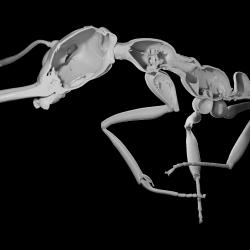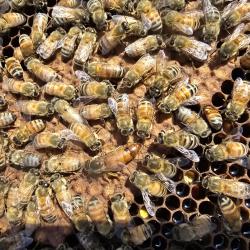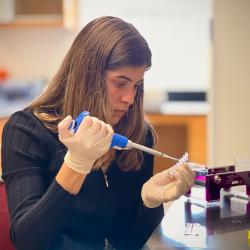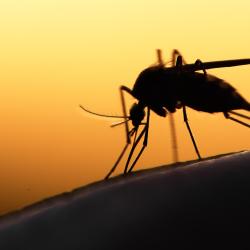Rocky Mountain Wildflower Season Lengthens by More Than a Month
A unique 39-year study of wildflower blooms in a Colorado Rocky Mountain meadow shows more than two-thirds of alpine flowers have changed their blooming pattern in response to climate change. Not only are half the flowers beginning to bloom weeks earlier, but more than a third are reaching their peak bloom earlier, and others are producing their last blooms later in the year. The bloom season, which used to run from late May to early September, now lasts from late April to late September, according to University of Maryland Biology Professor David Inouye.
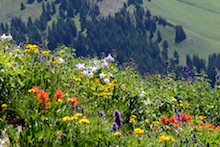 The wildflower records, made up of more than two million blooms, show that flowering plants’ response to climate change is more complex than previously believed, with different species responding in unexpected ways. The combinations of flower species that bloom together are changing too, with potential impacts on insects and birds. Studies that focus only on the date of flowers’ first bloom – as most do – understate these changes, said Inouye, the senior author of a study published March 17, 2014 in the Proceedings of the National Academy of Sciences.
The wildflower records, made up of more than two million blooms, show that flowering plants’ response to climate change is more complex than previously believed, with different species responding in unexpected ways. The combinations of flower species that bloom together are changing too, with potential impacts on insects and birds. Studies that focus only on the date of flowers’ first bloom – as most do – understate these changes, said Inouye, the senior author of a study published March 17, 2014 in the Proceedings of the National Academy of Sciences.
Phenology, the study of the timing of seasonal events, is crucial to understanding how climate change is affecting plants, animals and the relationships that bind them into natural communities. To answer these questions, phenologists are collecting modern data and poring through old records like amateur naturalists’ notebooks.
“Most studies rely on first dates of events like flowering or migration, because they use historical data sets that were not intended as scientific studies,” Inouye said. “First flowering is easy to observe. You don’t have to take the time to count flowers. So that’s often the only information available. It has taken a lot of effort to get the comprehensive insights needed for this analysis, which helps us understand how ecological communities are going to change in the future.”
Inouye was not thinking of the effects of a warming climate in 1974, when he began counting flowers on a mountainside 9,500 feet above sea level at the Rocky Mountain Biological Laboratory in Crested Butte, Colo.
“I was a graduate student studying hummingbirds and bumble bees, and I wanted to know what flower nectar resources are available for them, so I started counting flowers,” Inouye said.
Others initially took part, but Inouye stuck with it. Eventually he set his own students to the task. By counting blooms in each of 30 plots every other day, up to five months per year, for four decades, the group amassed a data set of more than 2 million flowers they have counted. For this study, University of Arizona doctoral student Paul CaraDonna, University of Maryland postdoctoral research associate Amy Iler and Inouye looked at data on the 60 most common species.
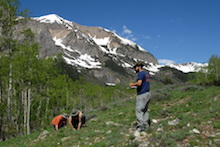 Bloom times are changing fast, the researchers found. The date the first spring flower appears has advanced more than 6 days per decade over the course of the study. The spring peak, when masses of wildflowers burst into bloom, has moved up 5 days per decade. And the last flower of fall occurred about 3 days later every decade. “The flowering season is about one month longer than it used to be” Iler said, “which is a big change for a mountain ecosystem with a short growing season.”
Bloom times are changing fast, the researchers found. The date the first spring flower appears has advanced more than 6 days per decade over the course of the study. The spring peak, when masses of wildflowers burst into bloom, has moved up 5 days per decade. And the last flower of fall occurred about 3 days later every decade. “The flowering season is about one month longer than it used to be” Iler said, “which is a big change for a mountain ecosystem with a short growing season.”
Of all the species that have changed their flowering schedules in some way, only 17% shifted their entire bloom cycle earlier. The rest showed more complicated changes.
“What we show is that first flowering isn’t always the best predictor of all the changes we find,” CaraDonna said. “There’s a lot more going on than you can get from this single, simple measure. So it’s important to take a closer look in order to understand all the ways that climate change affects these wildflower communities.”
The study “relies on long-term data to drive home the fact that species’ responses to climate change are complex,” said Saran Twombly, program director in the National Science Foundation (NSF)’s Division of Environmental Biology, which helped fund the research.
As the plants’ bloom patterns continue to change, researchers expect some plants that used to bloom simultaneously will no longer overlap, and others will start blooming together for the first time. Ecologists refer to these new combinations as “no analog communities.”
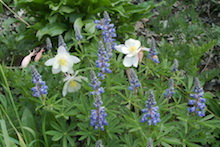 “We usually think of no analog communities as something that happens when plants or animals move into areas where they haven’t lived before, creating novel combinations of species,” Iler said. “For example, we have red foxes at our study site now. It used to be too cold for them in winter. Now the marmots that live there have to deal with a new predator. But this study shows that even when species don’t actually move, changes in the timing of key events in their life cycles may also result in no analog communities, where species may interact differently than before.”
“We usually think of no analog communities as something that happens when plants or animals move into areas where they haven’t lived before, creating novel combinations of species,” Iler said. “For example, we have red foxes at our study site now. It used to be too cold for them in winter. Now the marmots that live there have to deal with a new predator. But this study shows that even when species don’t actually move, changes in the timing of key events in their life cycles may also result in no analog communities, where species may interact differently than before.”
The changes are likely to have a strong impact – for better or worse – on pollinating insects and migratory birds. For example, Inouye said, hummingbirds that summer in the Rocky Mountains time their nesting so that their eggs hatch at peak bloom, when there is plenty of flower nectar for hungry chicks. But as the bloom season lengthens, the plants are not producing more flowers. The same number of blooms is spread out over more days, so at peak bloom there may be fewer flowers.
Will there be enough food for the hummingbirds’ young? To find out, Inouye plans to fit adult hummingbirds with radio transmitters and study how they interact with this summer’s blooms.
This research was funded by National Science Foundation grants DEB 75-15422, DEB 78-07784, BSR 81-08387, DEB 94-08382, IBN 98-14508, DEB 02-38331, DEB 09-22080 and DGE-1143953, with additional support from Earthwatch.
-College of Computer, Mathematical and Natural Sciences-
Media Contact: Abby Robinson, 301-405-5845, abbyr@umd.edu
Writer: Heather Dewar, 301-405-9267, hdewar@umd.edu
“Shifts in flowering phenology reshape a subalpine plant community,” by Paul J. CaraDonna, Amy M. Iler and David W. Inouye, published online March 17, 2014 in Proceedings of the National Academy of Sciences.



